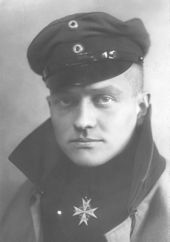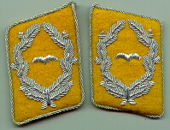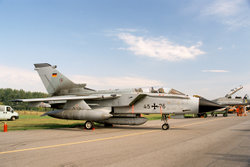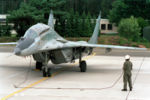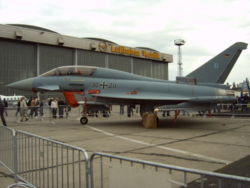Luftwaffe
2007 Schools Wikipedia Selection. Related subjects: World War II

The Deutsche Luftwaffe or Luftwaffe (German: air force, literally "Air Weapon", IPA: ['luftvafə]) is the commonly used term for the German air force. Generally, the word Luftwaffe is not restricted to any particular country, so "die Britische Luftwaffe" would mean "the British Air Force".
Unlike other air forces, the German Air Force not only operates aircraft, but comprises also the services of the "Einsatzführungsdienst" (Tactical Air Control Service) and Ground Based Air Defense named "FlaRak-Dienst" (Flugabwehr-Raketen-Dienst, commonly known as SAM).
The history of the German military aviation forces began in 1910 with the founding of the Imperial German Army Air Service, yet it has not been continuous because Germany lost both World Wars (1914-1918 and 1939-1945). As a result, Germany had no military air force between 1918 and 1935 and again between 1945 and 1956.
Beside the well known military aviation part of the Luftwaffe, a very large ground based organization belongs to the Luftwaffe as of 1935 and throughout the entire phase of World War II. The Luftnachrichtentruppe as well as ground based air defense forces, better known as Flak actually comprised of the biggest part of the Luftwaffe in terms of personnel and material. During wartime, new capabilities like radar assisted air surveillance and use of radar in support of the Flak as well as first attempts of what later became Ground Controlled Intercepts (GCI) were developed and successfully executed.
In 1939-1940, the Luftwaffe helped the German army to astonishingly rapid success in both Eastern and Western Europe, but failed to win control of the skies over Great Britain. Later, despite its best efforts, it could not prevent the defeat of Germany either by day, or by night, owing to constant Allied bombing of Germany's factories and cities by a numerically overwhelming force of bombers based in England. This was coupled with the advances of the Soviet armies from the East, as numbers of available German aircraft dwindled in the face of ever-growing numbers of Soviet aircraft. The Luftwaffe was, however, notable in putting the world's first jet fighter and the world's only rocket-powered fighter into action during the war.
|
|||||||||||||||||
Following the division of Germany after the World War II both West Germany and The German Democratic Republic established their own air forces; West Germany's Luftwaffe was founded in 1956 and the GDR's Luftstreitkräfte der NVA was established in 1955. The Luftstreitkräfte was subsumed into the Luftwaffe following German reunification in 1990. Only in Kosovo in 1999 has the Luftwaffe ever seen war action since the end of World War II.
Continuing the same composition of forces and weapon system categories, the new Luftwaffe as of 1956 included the successor of the Luftnachrichtentruppe, now called Radarführunsgdienst as well as the successor of the Flak air defense organisation, again as integral part of the new Luftwaffe. With the help of NATO, radar heads and bunker installations were erected in West-Germany as part of the NATO Integrated Air Defense System (NATINADS), basicly a mixed chain of radar stations, command and control facilities, airbases for air defense jet fighters and SAM-sites. This chain extended from North-Norway all the way through Europe along the Iron Curtain ending in East-Turkey.
The use of radar for air surveillance and SAM continued under the auspices of the new Luftwaffe which was not always the case in other NATO member states. In the USA for example, SAM was and still is integral part of the US Army.
History
World War I
The forerunner of the Luftwaffe, the Imperial German Army Air Service (Luftstreitkräfte), was founded in 1910 before the outbreak of World War I (1914–1918) with the emergence of military aircraft, although they were intended to be used primarily for reconnaissance in support of armies on the ground, just as balloons had been used in the same fashion during the Franco-Prussian War of 1870–1871 and even as far back as the Napoleonic Wars. It was not the world's first air force, however, because France's embryonic army air service, which eventually became the Armée de l'Air, had also been founded in 1910, and Britain's Royal Flying Corps (which merged in 1918 with the Royal Naval Air Service to form the Royal Air Force), was founded in 1912.
During the war, the Imperial Army Air Service utilised a wide variety of aircraft, ranging from fighters (such as those manufactured by Albatros-Flugzeugwerke and Fokker), reconnaissance aircraft (Aviatik and DFW) and heavy bombers ( Gothaer Waggonfabrik, better known simply as Gotha, and Zeppelin-Staaken).
However, the fighters received the most attention in the annals of military aviation, since it produced "aces" such as Manfred von Richthofen, popularly known in English as "The Red Baron" (in Germany, he was known as "der rote Baron"), Ernst Udet, Hermann Göring, Oswald Boelcke (considered the first master tactician of "dogfighting"), Max Immelmann (the first airman to win the Pour le Mérite, Imperial Germany's highest decoration for gallantry, as a result of which the decoration became popularly known as the "Blue Max"), and Werner Voss. As well as the German Navy, the German Army also used Zeppelins as airships for bombing military and civilian targets in France and Belgium as well as the United Kingdom.
All German and Austro-Hungarian military aircraft in service used the Iron Cross insignia until early 1918. Afterwards, the Balkenkreuz, a black Greek cross on white, was introduced.
After the war ended in German defeat, the service was dissolved completely under the conditions of the Treaty of Versailles, which demanded that its aeroplanes be completely destroyed. As a result of this disbanding, the present-day Luftwaffe (which dates from 1956) is not the oldest independent air force in the world, since the Royal Air Force of the United Kingdom is older, having been founded on 1 April 1918.
Inter-war period
Since Germany had been banned by the Treaty of Versailles from having an air force, there existed the need to train its pilots for a future war in secret. Initially, civil aviation schools within Germany were used, yet only light training planes could be used in order to maintain the facade that the trainees were going to fly with civil airlines such as Lufthansa. In order to train its pilots on the latest combat aircraft, Germany ironically solicited the help of its future enemy, the USSR, which was also isolated in Europe. A secret training airfield was established at Lipetsk in 1924 and operated for approximately nine years using mostly Dutch and Russian, but also some German, training aircraft before being closed in 1933. This base was officially known as 4th squadron of the 40th wing of the Red Army.
On February 26, 1935, Adolf Hitler ordered Hermann Göring to reinstate the Luftwaffe, breaking the Treaty of Versailles signed in 1919. Germany broke it without sanction from Britain and France or the League of Nations, yet neither the two nations nor the League did anything to oppose either this or any other action which broke the provisions of the Treaty. Although the new air force was to be run totally separately from the army, it retained the tradition of according army ranks to its officers and airmen, a tradition retained today by the Bundesluftwaffe of the unified Germany and by many air forces throughout the world. However, it is worth noting that, before the official promulgation of the Luftwaffe, what was a paramilitary air force was known as the Deutscher Luftverband ("German Air Union"; DLV for short), with Ernst Udet as its head, and the DLV uniform insignia became those of the new Luftwaffe, although the DLV "ranks" were actually given special names that made them sound more civilian than military.
Dr. Fritz Todt, the engineer who founded the forced labour Organisation Todt, was appointed to the rank of Generalmajor in the Luftwaffe. He was not, strictly speaking, an airman, although he had served in an observation squadron during World War I, winning the Iron Cross. He died in an air crash in February 1942.
It is said that Hermann Göring has personally chosen an emblem for the Luftwaffe that differed from that of the other armed branches. The eagle, an old symbol of the German Empire remained, but in another posture. Since 1933, when Hitler's National Socialist Party came to power, the eagle held between his claws the symbol of the party - the swastika (an old symbol of sunrise), which usually was enveloped by an oak wreath. Göring refused for the Luftwaffe the old heraldic eagle that appeared too stylized, too static and too massive, and he chose a younger, more natural and lighter eagle with wings spread in flying position that was more suitable for an air force. While the Wehrmacht eagle held firmly with his both claws the symbol of the Nazi Party, the Luftwaffe eagle held the swastika only with one claw while the other was bent in a threatening gesture.
The Luftwaffe had the ideal opportunity to test its pilots, aircraft and tactics in the Spanish Civil War of 1936–1939, when the Condor Legion was sent to Spain in support of the anti-Republican government revolt led by Francisco Franco. Modern machines included names which would become world famous: the Junkers Ju 87 Stuka dive-bomber and the Messerschmitt Bf 109 fighter plane. However, as aircraft seconded to Franco's Nationalist air force, Luftwaffe markings were replaced so as not to make the world believe that Germany was actively supporting the revolt. Instead of the Nazi Party's swastika on the tailplane, the German planes used the Nationalist air force aircraft markings (a Saint Andrew's cross over a white background, painted on the rudder of the aircraft and a black disc on fuselage and wings). All aircraft in the Legion were affiliated to units given a designation ending in the number 88. For example, bombers were in Kampfgruppe ("Combat Group") 88, abbreviated to K/88, and fighters in Jagdgruppe ("Pursuit Group") 88, J/88.
A grim foretaste of the systematic bombing of cities during World War II came in April 1937 when a combined force of German and Italian bombers under National Spanish command destroyed most of the Basque city of Gernika in north-east Spain. This bombing received worldwide condemnation, and the collective memory of the horror of the bombing of civilians has ever since become most acute via the famous painting, named after the town, by the Cubist artist, Pablo Picasso. Many feared that this would be the way that future air wars would be conducted, since the Italian strategist, General Giulio Douhet (who had died in 1930), had formulated theories regarding what would be dubbed "strategic bombing", the idea that wars would be won by striking from the air at the heart of the industrial muscle of a warring nation, and thus demoralising the civilian population to the point where the government of that nation would be driven to sue for peace—a portent of things to come, certainly, and not just during the war which would break out in Europe only months after the end of the civil war in Spain.
World War II
At the outset of the war, the Luftwaffe was one of the most modern, powerful, and experienced air forces in the world, dominating the skies over Europe with aircraft that were much more advanced than their initial counterparts. The Luftwaffe was central to the German Blitzkrieg doctrine, as the close air support provided by Stuka dive bombers and an overwhelming force of tactical fighters were key to several early successes. Following the Battle of Britain, however, the Luftwaffe went into a steady, gradual decline that saw it both outclassed and outgunned by the sheer number of Allied aircraft being deployed against it. Towards the end of the war the Luftwaffe was no longer a major factor, and despite fielding advanced aircraft like the Me262, was crippled by fuel shortages, insufficient production capacity, and a lack of trained pilots.
Cold War
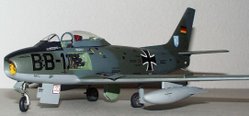
(Model by Peter Mojzisek Gallery/CL13Sabre/CL-13 Sabre.htm)
Following the war, German aviation in general was severely curtailed, and military aviation was completely forbidden when the Luftwaffe was officially disbanded in August 1946 by the Allied Control Commission. This changed when West Germany joined NATO in 1955, as the Western Allies believed that Germany was needed in view of the increasing threat militarily from the USSR and its Warsaw Pact allies. Throughout the following decades, the West German Luftwaffe was equipped mostly with U.S.-designed aircraft manufactured locally under licence. All aircraft sported—and continue to sport—the Iron Cross on the fuselage, harking back to the days of World War I, while the national flag of West Germany could be seen on the tailplanes.
Many well-known fighter pilots, who had fought with the Luftwaffe in World War II, joined the new post-war air force and underwent refresher training in the U.S. before returning to West Germany to upgrade on the latest U.S.-supplied hardware. These included Erich Hartmann, the highest-ever scoring ace (352 enemy aircraft destroyed), Gerhard Barkhorn (301), Günther Rall (275) and Johannes Steinhoff (176). Steinhoff, who suffered a crash in a Messerschmitt Me 262 shortly before the end of the war which resulted in lifelong scarring of his face and other parts of his body, would eventually become commander-in-chief of the Luftwaffe, with Rall as his immediate successor. Hartmann retired as an Oberst (colonel) in 1970 aged 48. The aforementioned Josef Kammhuber also served with the post-war Luftwaffe, retiring in 1962 as Inspekteur der Bundesluftwaffe.
1960's Starfighter crisis
During the 1960's, the " Starfighter crisis" was a big problem for German politics, as many of these Lockheed F-104 fighters crashed after being modified to serve for Luftwaffe purposes - specifically for terrain, weather and ground troop support issues. In Luftwaffe service, 292 of the 916 Starfighters crashed, claiming the lives of 115 pilots, leading to cries from the West German public that the Starfighter was fundamentally unsafe and earning it the Witwenmacher (English - Widowmaker) nickname.
Steinhoff and his deputy Rall noted that the non-German F-104's proved much safer - Spain lost none in the same period. The Americans blamed the high loss rate of the Luftwaffe F-104s to the extreme low-level and aggressive flying by the German pilots, rather than any faults in the aircraft.. Steinhoff and Rall immediately left their daily work and learned to fly the aircraft in America under Lockheed instruction, and noted some specifics in the training (a distinct lack of mountains and foggy weather training), combined with handling capabilities (sharp start high G turns) of the aircraft that could create accidents situations.
Steinhoff and Rall immediately changed the training regimen for the F-104 pilots, and accident ratio's quickly fell to those comparable or better than other airforces. They also brought about the high level of training and professionalism seen today throughout the Luftwaffe, and the start of a strategic direction for Luftwaffe pilots to tactically and combat train outside Germany. However, the F-104 never removed its Witwenmacher reputation, and was replaced much earlier by the Luftwaffe than other national airforces
1970's
From 1965 through 1970, two surface to surface missile wings (Flugkörpergeschwader) fielded 16 of the Pershing I missile systems with nuclear warheads under US Army custody. In 1970, the system was upgraded to Pershing IA with 72 systems. Although not directly affected by the 1988 Intermediate-Range Nuclear Forces Treaty, the Luftwaffe unilaterally agreed to the retrograde of the Pershing 1A system from their inventory in 1991, and the missiles were destroyed.
Beginning in June 1979 the Luftwaffe received 212 Panavia Tornado IDSs.
The United States provides nuclear weapons for use by Germany under a NATO nuclear sharing agreement. As of 2005, 60 tactical B61 nuclear bombs are provided, stored at Büchel and Ramstein Air Bases, which in time of war would be delivered by Luftwaffe Panavia Tornados.
Reunification

The GDR's air force, the Luftstreitkräfte der NVA, was supplied exclusively with Eastern Bloc-produced aircraft, such as the Sukhoi Su-17 "Fitter" and the more famous Mikoyan-Gurevich (MiG) family of aircraft, such as the MiG-21, MiG-23 and MiG-29 fighters, and served primarily as an extension of Red Air Force units in Eastern Germany. The East German air force was unique among Warsaw Pact countries in that it was often equipped with Soviet-standard combat aircraft, instead of downgraded export models. As an extension of Soviet air power, the "Luftstreitkräfte" enjoyed less autonomy than other Eastern Bloc air forces. Unlike the West German Luftwaffe, the markings sported on the aircraft reflected the identity of the country as belonging to the Communist bloc. These markings consisted of a diamond-shaped design, in which could be seen the vertically oriented three stripes in black, red and gold surmounted by the stylised hammer, compass and wreath-like ears-of-grain design, which was also seen on the Flag of East Germany, although the stripes were a 90-degree orientation from those to be seen on either national flag of the two German nations between 1959 and 1990.
After the GDR and West Germany were reunified in October 1990, the aircraft of the NVA were taken over by the unified Federal Republic of Germany, and their GDR markings were replaced by the Iron Cross, thus creating the situation of Soviet-built aircraft serving in a NATO air force. However, most of these would eventually be taken out of service altogether, in many cases being sold to the new Eastern European allies now part of NATO, such as Poland and the Baltic states.
The exception to this was the Jagdgeschwader 73 "Steinhoff" in Laage. The pilots of this squadron flew MiG-29s acquired during the reunification and were some of the most experienced MiG-29 pilots in the world. One of their primary duties was to serve as aggressor pilots, training other pilots in dissimilar combat tactics. The United States sent a group of fighter pilots to Germany during the Red October exercise in order to practice real tactics against the aircraft they were most likely to meet in real combat. In 2004, however, the MiG-29s were sold to Poland. Since then, the JG 73 uses the Eurofighter Typhoon.
1990s
In March 1999, for the first time since 1945, the Luftwaffe engaged in combat operations as part of the NATO-led Kosovo War. This event was noted as significant in the British press with The Sun running the headline "Luftwaffe and the RAF into battle side by side". The Luftwaffe flew suppression of enemy air defence ( SEAD) sorties. No Luftwaffe aircraft were lost during the campaign, but the force's role proved to be controversial in Germany because of the strong pacifist sentiment still present in the population that is opposed to the use of force by Germany in international affairs. Moreover, there were constitutional concerns, because Germany was not and, indeed, still is not allowed to participate in "wars of aggression" owing to its 1949 Grundgesetz ("Basic Law" - constitution).
2000s
In 2005, 4 F-4F Phantoms participated on NATO's Baltic Air Policing operation.
Future
Since the 1970s, the Luftwaffe of West Germany and later the reunited Germany (as well as many other European air forces) has actively pursued the construction of European combat aircraft such as the Panavia Tornado and more recently the Eurofighter Typhoon, which has been introduced in 2006.
On January 13 2004 the then German Defence Minister Peter Struck announced major changes to the German armed forces. A major part of this announcement is the plan to cut the German fighter fleet from 426 in early 2004 to 265 by 2015. Assuming the full German order for 180 Eurofighter Typhoons is fulfilled, this will see the Tornado force reduced to 85. The German Navy's air wing (Marineflieger) received 112 Tornado IDSs. In late 2004 the last Tornado unit was disbanded. The maritime combat role has been assumed by the Luftwaffe a unit of which has had its Tornados upgraded to carry the Kormoran II and AGM-88 HARM missiles.
Tactical Training Centers
In light of the destroyed infrastructure of West Germany post World War 2, the restrictions on aircraft production placed on Germany and the later restrictive flying zones available for training pilots, the reconstructed Luftwaffe trained most of its pilots tactically away from Germany, mainly in the United States where most of its aircraft were sourced from.
During the 1960's and 1970's, when large numbers of Luftwaffe jets began to crash - the Luftwaffe suffered a 36 percent crash rate for F-84F Thunderstreak, and almost 30 percent loss of the F-104 Starfighter - created demands from Germany's citizens that the Luftwaffe move most combat training away from Germany.
Resultantly, the Luftwaffe set up two Tactical Training centres: one, like many of the NATO forces at the Canadian Forces Air Command base at Goose Bay; and a second one in a unique partnership with the United States Airforce at Holloman AFB in New Mexico. Both of these facilities provide access to large unpopulated areas, where tactical and combat training can take place without danger to large populations.
In September 2004, Luftwaffe chief of staff, Klaus-Peter Stieglitz announced a reduction in its training program of roughly 20%.
Holloman AFB
On 1 May 1996, the Luftwaffe established the German Air Force Tactical Training Centre in concept with the United States Air Force 20th Fighter Squadron which provides aircrew training in the F-4F Phantom II. The TTC serves as the parent command for two German air crew training squadrons. The F-4 Training Squadron oversees all German F-4 student personal affairs, and provides German instructor pilots to cooperate in the contracted F-4 training program provided by the U.S. Air Force (20th Fighter Squadron). A second TTC unit, the Tornado Training Squadron, provides academic and tactical flying training, by German Air Force instructors, for German Tornado aircrews.
The first contingent of Tornado aircraft arrived at Holloman in March 1996. More than 300 German Air Force members are permanently assigned at Holloman to the TTC - the only unit of its kind in the United States. The German Air Force Flying Training Centre activated 31 March with German Air Force Chief of Staff Gen. Portz and U.S. Air Force Chief of Staff Gen. Michael Ryan present. The Luftwaffe has since kept up to 800 personnel at Holloman for training exercises, due to limited training space in Europe.
On 29 September 1999 two Luftwaffe Tornado's crashed near Marathon Indian Basin, about 15 miles northwest of Carlsbad, New Mexico. The crash details were kept quiet from the American public, as the crash was investigated under Luftwaffe jurisdiction.. Subsequent questioning of the authorities revealed that a training agreement existed between the United States and various foreign national governments post World War II.
Organisation
- Jagdgeschwader 73 - Eurofighter Typhoon
- Jagdgeschwader 74 - Eurofighter Typhoon - Neuburg an der Donau
